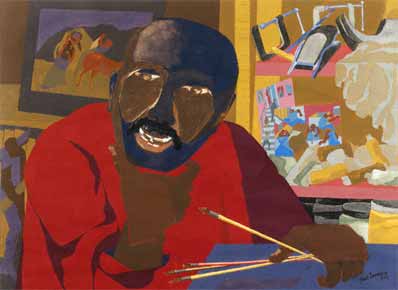This painting is of Jacob Lawrence himself just sitting at a desk. In his hands he has what appears to be four paint brushes. In the background you can see a painting right behing Lawrence's head. I think that this means he always has art in the back of his mind. He has his head resting in his right hand, looking off in the distance. He seems to be thinking about what his next piece of artwork is going to be. Behind his left shoulder, there are different tools, pictures, and paint. It shows us that he must be sitting in his work place. The smile on his face tells us that he seems to be a very happy person when he is working. His bright colors represent his mood.
Jacob Lawrence was very determined to show the world of the lives of African Americans through his paintings. In his youth, his life at home was not happy. He would go to the Library, the Harlem Art Workshop, or the Metropoitan Museum of Art. After studying at the Harlem Art Workshop for two years, he realized what he was going to do. When he was twenty he had started exhibiting his work.
"My belief is that it is most important for an artist to develope an approach and pilosophy about life- if he has developed this philosophy he does not put paint on canvas, he puts himself on canvas." (pg.174)
Title: Jacob Lawrence
Quoted from Jacob Lawrence
Source: Living With Art, Eigth Edition, Copywrite 2008

